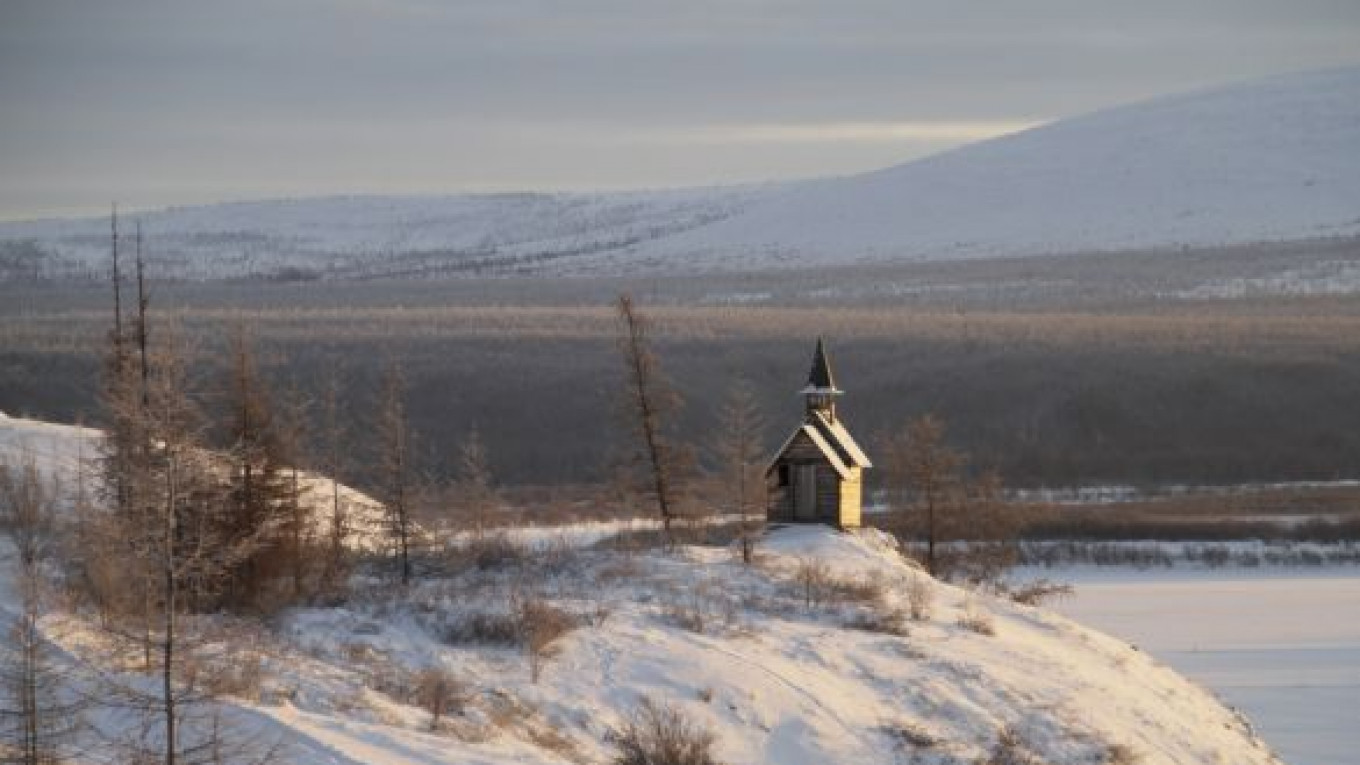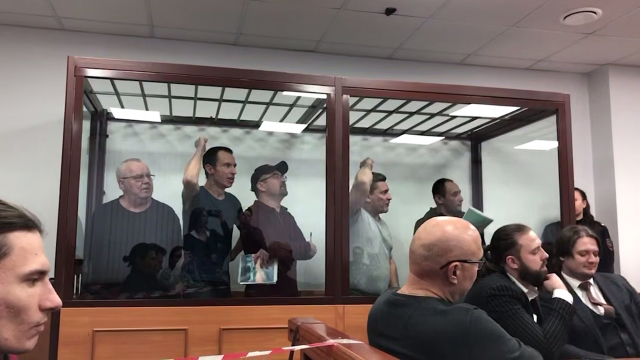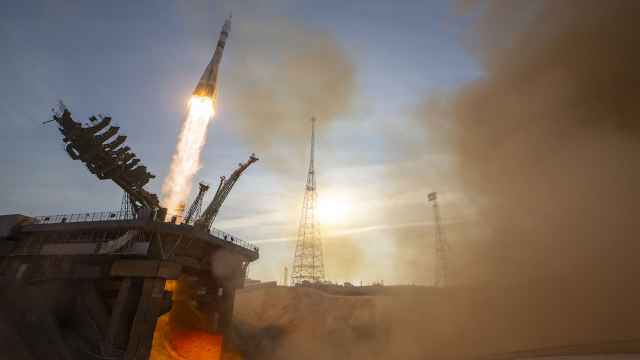CHERSKY, Sakha Republic — The scientist shuffles across the frozen lake, scuffing aside ankle-deep snow until he finds a cluster of bubbles trapped under the ice. With a cigarette lighter in one hand and a knife in the other, he lances the ice like a blister. Methane whooshes out and bursts into a thin blue flame.
Gas locked inside Siberia’s frozen soil and under its lakes has been seeping out for thousands of years. But in the past few decades, as the Earth has warmed, the icy ground has begun thawing more rapidly, accelerating the release of methane — a greenhouse gas 23 times more powerful than carbon dioxide — at a perilous rate.
Some scientists believe the thawing of permafrost could become the epicenter of climate change. They say 1.5 trillion tons of carbon locked inside icebound earth is a climate time bomb waiting to explode if released into the atmosphere.
“Here, total carbon storage is like all the rain forests of our planet put together,” says the scientist, Sergei Zimov — “here” being the endless sweep of snow and ice stretching toward Siberia’s gray horizon, as seen from Zimov’s research facility nearly 350 kilometers above the Arctic Circle.
Climate change moves back to centerstage on Nov. 29 when governments meet in Cancun, Mexico, to try again to thrash out a course of counteractions. But UN officials hold out no hope that the two weeks of talks will lead to a legally binding accord governing carbon emissions, seen as the key to averting what is feared might be a dramatic change in climate this century. Most climate scientists, with a few dissenters, say human activities — the stuff of daily life like driving cars, producing electricity or raising cattle — is overloading the atmosphere with carbon dioxide, methane and other gases that trap heat, causing a warming effect.
But global warming is amplified in the polar regions. What feels like a modest temperature rise is enough to induce Greenland glaciers to retreat, Arctic sea ice to thin and contract in summer, and permafrost to thaw faster, both on land and under the seabed. Yet awareness of methane leaks from permafrost is so new that it was not even mentioned in the seminal 2007 report by the Intergovernmental Panel on Climate Change, which warned of rising sea levels inundating coastal cities, dramatic shifts in rainfall disrupting agriculture and drinking water, the spread of diseases and the extinction of species.
“In my view, methane is a serious sleeper out there that can pull us over the hump,” said Robert Corell, an eminent U.S. climate change researcher and Arctic specialist.
Corell, speaking by telephone from a conference in Miami, said he and other U.S. scientists are pushing Washington to deploy satellites to gather more information on methane leaks.
The lack of data over a long period of time casts uncertainty over the extent of the threat. An article last August in the journal Science quoted several experts as saying it’s too early to predict whether Arctic methane will be the tipping point. “Arctic Armageddon Needs More Science, Less Hype,” was its headline.
Studies indicate that cold-country dynamics on climate change are complex. The Arctic Monitoring and Assessment Program, a scientific body set up by the eight Arctic rim countries, says overall the Arctic is absorbing more carbon dioxide than it releases. “Methane is a different story,” said its 2009 report. The Arctic is responsible for up to 9 percent of global methane emissions. Other methane sources include landfills, livestock and fossil fuel production.
Katey Walter Anthony, of the University of Alaska Fairbanks, has been measuring methane seeps in Arctic lakes in Alaska, Canada and Russia, starting here around Chersky 10 years ago. She was stunned to see how much methane was leaking from holes in the sediment at the bottom of one of the first lakes she visited. “On some days it looked like the lake was boiling,” she said. Returning each year, she noticed this and other lakes doubling in size as warm water ate into the frozen banks.
“The edges of the lake look like someone eating a cookie. The permafrost gets digested in the guts of the lake and burps out as methane,” she said.
More than 50 billion tons could be unleashed from Siberian lakes alone, more than 10 times the amount now in the atmosphere, she said.
But the rate of defrosting is hard to assess with the data at hand. “If permafrost were to thaw suddenly, in a flash, it would put a tremendous amount of carbon in the atmosphere. We would feel temperatures warming across the globe. And that would be a big deal,” she said. But it may not happen so quickly. “Depending on how slow permafrost thaws, its effect on temperature across the globe will be different,” she said.
Permafrost is defined as ground that has stayed below freezing for more than two consecutive summers. In fact, most of Siberia and the rest of the Arctic, covering one-fifth of the Earth’s land surface, have been frozen for millennia.
During the summer, the ground can defrost to a depth of several feet, turning to sludge and sometimes blossoming into vast fields of grass and wildflowers. Below that thin layer, however, the ground remains frozen, sometimes encased in ice dozens or even hundreds of meters thick. As the Earth warms, the summer thaw bites a bit deeper, awakening ice-age microbes that attack organic matter — vegetation and animal remains — buried where oxygen cannot reach, producing methane that gurgles to the surface and into the air.
The newly released methane adds to the greenhouse effect, trapping yet more heat, which deepens the next thaw, in a spiraling cycle of increasing warmth.
The U.S. National Oceanic and Atmospheric Administration, in its 2010 Arctic Report Card issued last month, said the average temperature of the permafrost has been rising for decades, but noted “a significant acceleration” in the last five years on the Arctic coast.
One of those spots would be Chersky, an isolated town on the bank of the Kolyma River at the mouth of the East Siberia Sea. The ground in this remote corner of the world has warmed about 2 degrees Celsius in the last five years, to about minus 5 C today, said Zimov, director of the internationally funded Northeast Science Station, which is about 3 kilometers from town. The warming is causing the landscape to buckle under his feet. “I live here more than 30 years. … There are many [dirt] roads in our region which I used or built myself, but now I can’t use anymore. Now they look like canyons,” he said.
Buildings, too, collapse. The school in Chersky, a Soviet-era structure with a tall bronze statue of Karl Marx on its doorstep, was abandoned several years ago when the walls began to crack as the foundations gave way. The northern Siberian soil, called yedoma, covers 1.8 million square kilometers and is particularly unstable. Below the surface are vertical wedges of ice, as if 15-story-high icicles had been hammered into the soft ground, rich in decaying vegetation, over thousands of years.
As the air warms, the tops of the wedges melt and create depressions in the land. Water either forms a lake or runs off to lower ground, creating a series of steep hillocks and gullies. During summer, lakeside soil may erode and tumble into the water, settling on the bottom where bacteria eat it and cough up yet more methane.
The process takes a long time, but Zimov has done a simulation by bulldozing trees and scraping off moss and surface soil from 1 hectare of former larch forest, rendering it as if it had been leveled by fire. Seven years later the previously flat terrain is carved up with crevices three to five meters deep, creating a snowy badlands. Gazing across a white river to the apartment blocks on a distant hill, Zimov said, “In another 30 years all of Chersky will look like this.”
A Message from The Moscow Times:
Dear readers,
We are facing unprecedented challenges. Russia's Prosecutor General's Office has designated The Moscow Times as an "undesirable" organization, criminalizing our work and putting our staff at risk of prosecution. This follows our earlier unjust labeling as a "foreign agent."
These actions are direct attempts to silence independent journalism in Russia. The authorities claim our work "discredits the decisions of the Russian leadership." We see things differently: we strive to provide accurate, unbiased reporting on Russia.
We, the journalists of The Moscow Times, refuse to be silenced. But to continue our work, we need your help.
Your support, no matter how small, makes a world of difference. If you can, please support us monthly starting from just $2. It's quick to set up, and every contribution makes a significant impact.
By supporting The Moscow Times, you're defending open, independent journalism in the face of repression. Thank you for standing with us.
Remind me later.






